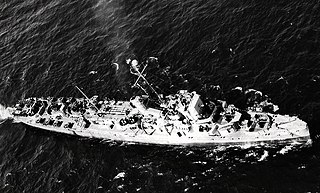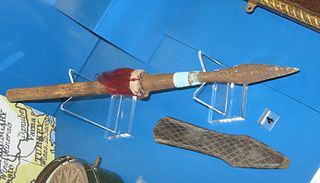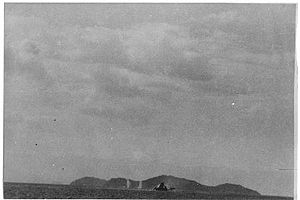
The third USS Rochester (CA-124), an Oregon City-class heavy cruiser, was laid down 29 May 1944 by Bethlehem Steel Co., Quincy, Massachusetts; launched 28 August 1945; sponsored by Mrs. M. Herbert Eisenhart, wife of the president of Bausch & Lomb Optical Co., Rochester, New York; and commissioned 20 December 1946 at the Boston Navy Yard, Captain Harry Aloysius Guthrie in command.

USS Naifeh (DE-352) was a John C. Butler-class destroyer escort in service with the United States Navy from 1944 to 1960. She was sunk as a target in 1966.

USS Rich (DE-695) was a Buckley-class destroyer escort, the first United States Navy ship named in honor of Lieutenant (j.g.) Ralph M. Rich (1916–1942) who was awarded the Navy Cross for his leadership as a fighter pilot off Enterprise during the Battle of Midway.

USS Endicott (DD-495), was a Gleaves-class destroyer of the United States Navy.

USS Doyle (DD-494/DMS-34), was a Gleaves-class destroyer of the United States Navy.

USS Pirate (AM-275) was an Admirable-class minesweeper built for the U.S. Navy during World War II. She was built to clear minefields in offshore waters, and served the Navy in the North Atlantic Ocean and then in the Pacific Ocean. She was returned to active service for the Korean War. During Operation Wonsan she struck a mine and sunk. For her dangerous work, she was awarded four battle stars for her Korean War effort.

USS Cofer (DE-208/APD-62) was a Buckley-class destroyer escort in service with the United States Navy from 1944 to 1946. She was scrapped in 1968.

The Blockade of Wonsan, or the Siege of Wonsan, from February 16, 1951 to July 27, 1953, during the Korean War, was the longest naval blockade in modern history, lasting 861 days. UN naval forces, primarily from the United States, successfully kept the strategically important city of Wonsan from being used by the North Korean Navy.

USS Pledge (AM-277) was an Admirable-class minesweeper built for the U.S. Navy during World War II. She was built to clear minefields in offshore waters, and served the Navy in the Atlantic Ocean and then was transferred to the North Pacific Ocean. She survived the world war and was awarded one battle star, but, during the Korean War, she struck a mine and was sunk. She received the Presidential Unit Citation for her Korean service.

USS Redstart (AM-378/MSF-378) was an Auk-class minesweeper commissioned by the United States Navy for service in World War II. Her task, as a fleet minesweeper, was to clear mines as the fleet proceeded into battle areas.

USS Impeccable (AM-320) was an Auk-class minesweeper built for the United States Navy during World War II. She was originally ordered as HMS Brutus (BAM-7) for the United Kingdom's Royal Navy under Lend-Lease, but was acquired and renamed by the United States Navy before construction began. She was commissioned in 1944 and served in the Pacific before being decommissioned in 1947. After the outbreak of hostilities in Korea, Impeccable was recommissioned in 1952 and served off Korea through 1952. She was decommissioned for the final time in October 1955 and placed in reserve. She was sold for scrapping in 1974.
USS Minivet (AM-371) was an Auk-class minesweeper acquired by the United States Navy for the dangerous task of removing mines from minefields laid in the water to prevent ships from passing.

The second USS Ardent (AM-340) was a Auk-class minesweeper in the United States Navy.

USS Tide (AM-125) was an Auk-class minesweeper acquired by the United States Navy for the dangerous task of removing mines from minefields laid in the water to prevent ships from passing.

USS Greer County (LST-799) was a LST-542-class tank landing ship (LST) built for the United States Navy during World War II. She was named for Greer County, Oklahoma on 1 July 1955, and the only U.S. Naval vessel to bear the name.

USS Mockingbird (AMS-27/YMS-419) was a YMS-1-class minesweeper of the YMS-135 subclass built for the United States Navy during World War II. She was the second U.S. Navy ship to be named Mockingbird.

USS Redhead (AMS-34/YMS-443) was a YMS-1-class minesweeper of the YMS-135 subclass built for the United States Navy during World War II. She was the first U.S. Navy ship to be named for the Redhead duck.

USS PGM-18 was a PGM-9-class motor gunboat built for the United States Navy during World War II. She was built and originally commissioned as USS PC-1255, a PC-461-class submarine chaser, and was decommissioned and converted in late 1944. USS PGM-18 struck a mine off the coast of Okinawa in April 1945; 13 men lost their lives when PGM-18 sank.

The Irene incident of 1927 was a significant event of the British anti-piracy operations in China during the first half of the 20th century. In an attempt to surprise the pirates of Bias Bay, about sixty miles from Hong Kong, Royal Navy submarines attacked the merchant ship SS Irene, of the China Merchants Steam Navigation Company, which had been taken over by the pirates on the night of 19 October. The British were successful in thwarting the hijacking though they sank the ship.






















